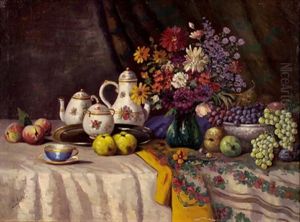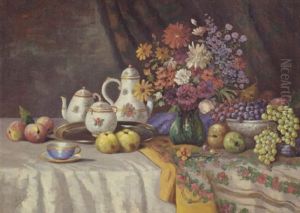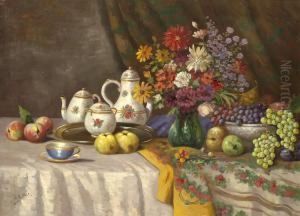Mileva Roller Paintings
Mileva Roller was an Austrian artist, born in 1886 in Vienna, Austria-Hungary. She emerged as a significant figure in the early 20th century Austrian art scene, known for her contributions to painting and graphic arts. Her work is often associated with the realms of Expressionism and Art Nouveau, blending vivid emotional depth with stylistic elegance. Roller's artistic journey was deeply influenced by the cultural vibrancy of Vienna at the turn of the century, a period marked by intellectual ferment and artistic innovation.
Educated at the Women's Academy (Frauenakademie) of the Vienna School of Arts and Crafts (Wiener Kunstgewerbeschule), Roller was among the pioneering women in the Austrian art world, a domain traditionally dominated by men. She was mentored by notable figures of the era, which helped hone her distinctive style. Her marriage to architect and designer Alfred Roller, a prominent member of the Vienna Secession movement, further integrated her into the heart of Vienna's artistic avant-garde. The couple's intellectual and artistic partnership was reflected in their collaborative works and their involvement in the Secession movement, which sought to break away from traditional art forms and promote modernist ideals.
Throughout her career, Mileva Roller's work exhibited a keen sensitivity to color and form, often exploring themes of femininity, nature, and the psychological. Her paintings and prints are characterized by their emotional intensity and technical finesse, capturing the tumultuous spirit of the era. Despite her contributions and the acclaim she received during her lifetime, Roller's legacy was somewhat overshadowed by her male contemporaries and the turbulent events of the 20th century, including both World Wars and the changing political landscape of Europe.
After World War II, Roller's artistic output declined, and she gradually receded from the public eye. She passed away in 1956 in Vienna, leaving behind a body of work that continues to be revisited and appreciated for its depth and beauty. In recent years, there has been a renewed interest in Mileva Roller's art, with exhibitions and research shedding light on her role in the development of modern Austrian art. Her work now occupies a valued place in the collections of several major museums, recognized for its contribution to the rich tapestry of European modernism.


